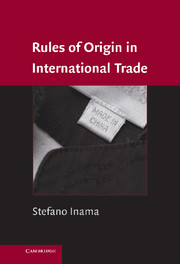Book contents
- Frontmatter
- Contents
- List of Figures
- List of Tables
- List of Acronyms
- Preface
- 1 Efforts to Establish Multilateral Rules
- 2 The Uruguay Round Agreement on Rules of Origin: The Harmonization Work Program of Nonpreferential Rules of Origin
- 3 Preferential Rules of Origin
- 4 The Economics of Rules of Origin
- 5 Drafting Preferential Rules of Origin
- 6 The Administration of Rules of Origin
- Index
5 - Drafting Preferential Rules of Origin
Published online by Cambridge University Press: 18 August 2009
- Frontmatter
- Contents
- List of Figures
- List of Tables
- List of Acronyms
- Preface
- 1 Efforts to Establish Multilateral Rules
- 2 The Uruguay Round Agreement on Rules of Origin: The Harmonization Work Program of Nonpreferential Rules of Origin
- 3 Preferential Rules of Origin
- 4 The Economics of Rules of Origin
- 5 Drafting Preferential Rules of Origin
- 6 The Administration of Rules of Origin
- Index
Summary
This chapter examines the various modalities for drafting rules origin. It aims at providing guidance to policy makers, customs, and the private sector on the issues to be considered and analyzed when drafting rules of origin. The chapter is divided in three sections. Section 5.1 reports the lessons learned from drafting the Generalized System of Preferences (GSP) rules of origin and the experience and feedback gained during the United Nations Conference on Trade and Development (UNCTAD) working group on rules of origin. Section 5.2 contains the experience on rules of origin of some major regional trading agreement among developing countries in Latin America, Africa, and Asia. Section 5.3 draws some conclusions and makes some suggestions on how to draft rules of origin. It contains a methodology on drafting product-specific rules of origin based on an input/output matrix derived from the Harmonized System (HS).
Learning Drafting Rules of Origin from the Past: Experience Gained with the Rules of Origin under the GSP
General Observations and Lessons Learned
As is widely known, first Secretary-General Raoul Prebistch of UNCTAD laid down the concept and intellectual foundations of the GSP. Once the principles and objectives of the GSP were finally agreed on at the second UNCTAD conference as contained in UNCTAD resolution 21(II,) the elements and structure of the GSP were still to be defined. To define and agree on these elements among UNCTAD member-states, intergovernmental machinery was created within UNCTAD.
- Type
- Chapter
- Information
- Rules of Origin in International Trade , pp. 389 - 529Publisher: Cambridge University PressPrint publication year: 2009



